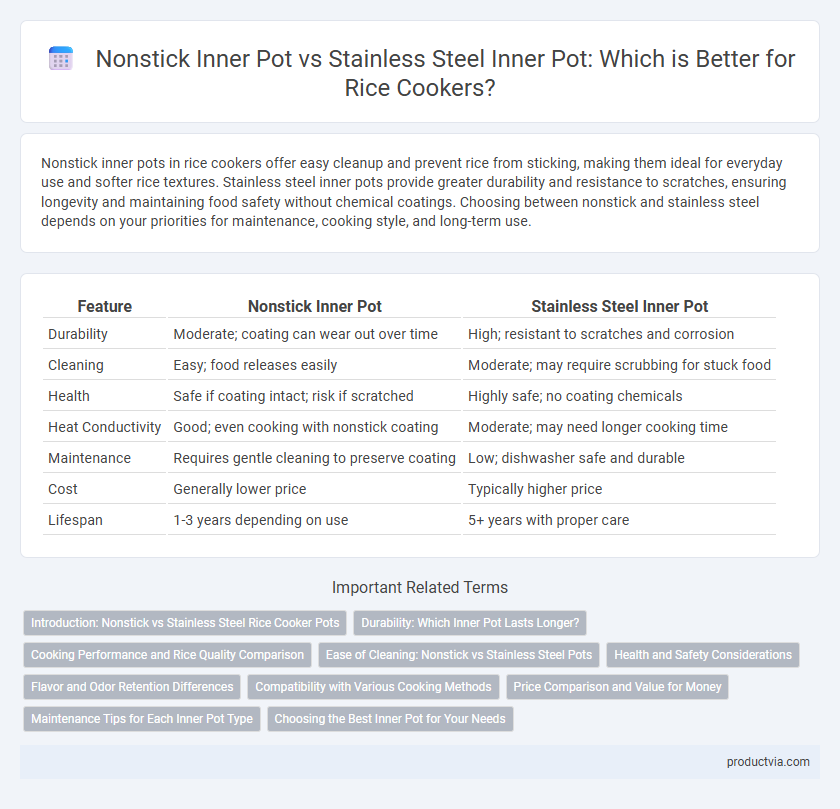Nonstick inner pots in rice cookers offer easy cleanup and prevent rice from sticking, making them ideal for everyday use and softer rice textures. Stainless steel inner pots provide greater durability and resistance to scratches, ensuring longevity and maintaining food safety without chemical coatings. Choosing between nonstick and stainless steel depends on your priorities for maintenance, cooking style, and long-term use.
Table of Comparison
| Feature | Nonstick Inner Pot | Stainless Steel Inner Pot |
|---|---|---|
| Durability | Moderate; coating can wear out over time | High; resistant to scratches and corrosion |
| Cleaning | Easy; food releases easily | Moderate; may require scrubbing for stuck food |
| Health | Safe if coating intact; risk if scratched | Highly safe; no coating chemicals |
| Heat Conductivity | Good; even cooking with nonstick coating | Moderate; may need longer cooking time |
| Maintenance | Requires gentle cleaning to preserve coating | Low; dishwasher safe and durable |
| Cost | Generally lower price | Typically higher price |
| Lifespan | 1-3 years depending on use | 5+ years with proper care |
Introduction: Nonstick vs Stainless Steel Rice Cooker Pots
Nonstick inner pots in rice cookers offer superior food release and easy cleaning due to their coated surface, preventing rice from sticking during cooking. Stainless steel inner pots provide excellent durability and resistance to scratching, maintaining structural integrity and safety over time without chemical coatings. Choosing between the two depends on priorities such as ease of maintenance, longevity, and potential health considerations related to coating wear.
Durability: Which Inner Pot Lasts Longer?
The stainless steel inner pot in rice cookers offers superior durability due to its resistance to scratching, chipping, and corrosion, ensuring long-term use without significant wear. Nonstick inner pots, while convenient for easy cleaning, tend to degrade over time as the coating can peel or scratch, reducing their lifespan. For users prioritizing longevity, stainless steel inner pots generally last longer and maintain their quality through extensive use.
Cooking Performance and Rice Quality Comparison
Nonstick inner pots provide even heat distribution and prevent rice from sticking, resulting in fluffy, well-cooked grains and easier cleanup. Stainless steel inner pots offer superior durability and resistance to scratches but may require more careful monitoring to prevent rice from sticking or burning. Cooking performance varies as nonstick coatings enhance moisture retention and texture, while stainless steel pots deliver a slightly firmer and less sticky rice quality.
Ease of Cleaning: Nonstick vs Stainless Steel Pots
Nonstick inner pots in rice cookers offer superior ease of cleaning due to their smooth coating that prevents rice from sticking, reducing scrubbing time and effort. Stainless steel pots often require more thorough cleaning to remove stuck-on food residues, which can be stubborn after cooking starchy rice dishes. For users seeking quick and effortless maintenance, nonstick pots provide a clear advantage in hassle-free cleanup.
Health and Safety Considerations
Nonstick inner pots in rice cookers often contain coatings like Teflon, which can release harmful fumes if overheated, posing potential health risks. Stainless steel pots avoid chemical coatings, offering a more inert surface that resists corrosion and does not leach substances into food, making them a safer option for long-term use. Choosing stainless steel inner pots enhances durability and food safety, particularly for users concerned about exposure to toxic materials during cooking.
Flavor and Odor Retention Differences
Nonstick inner pots in rice cookers prevent rice from sticking, enhancing ease of cleaning but may sometimes retain minor synthetic odors that can subtly affect flavor. Stainless steel inner pots do not absorb odors or flavors, preserving the pure taste of the rice, but require more careful cleaning to avoid sticking and burnt residues. Flavor and odor retention in stainless steel pots typically result in a more authentic rice experience compared to nonstick counterparts.
Compatibility with Various Cooking Methods
Nonstick inner pots excel in easy food release and quick cleaning but may not support high-heat cooking methods like searing or browning due to coating limitations. Stainless steel inner pots offer superior heat tolerance, allowing compatibility with diverse cooking techniques such as sauteing and simmering, enhancing the rice cooker's versatility. Selecting between nonstick and stainless steel inner pots depends on the desired cooking methods and maintenance preferences.
Price Comparison and Value for Money
Nonstick inner pots for rice cookers typically come at a lower price point, making them budget-friendly options for everyday use, while stainless steel inner pots usually cost more but offer greater durability and resistance to scratches. Despite the higher initial cost, stainless steel pots provide better long-term value for money due to their longevity and ease of cleaning without the risk of coating degradation. Consumers seeking cost-efficiency may prefer nonstick pots, whereas those prioritizing lasting performance often invest in stainless steel for improved return on investment.
Maintenance Tips for Each Inner Pot Type
Nonstick inner pots require gentle cleaning with soft sponges and mild detergents to preserve the coating and prevent scratches, avoiding metal utensils that can damage the surface. Stainless steel inner pots need thorough cleaning with warm soapy water and occasional scrubbing to remove rice residue, and they benefit from drying immediately to prevent water spots or rust. Regular maintenance of both types extends the rice cooker's lifespan and ensures optimal cooking performance.
Choosing the Best Inner Pot for Your Needs
Nonstick inner pots provide easy cleanup and prevent rice from sticking, making them ideal for users prioritizing convenience and low-maintenance cooking. Stainless steel inner pots offer superior durability and resistance to scratches, suitable for those seeking long-term performance and health-conscious materials. Selecting the best inner pot depends on balancing convenience, longevity, and personal cooking preferences.
Nonstick inner pot vs stainless steel inner pot for rice cookers Infographic

 productvia.com
productvia.com